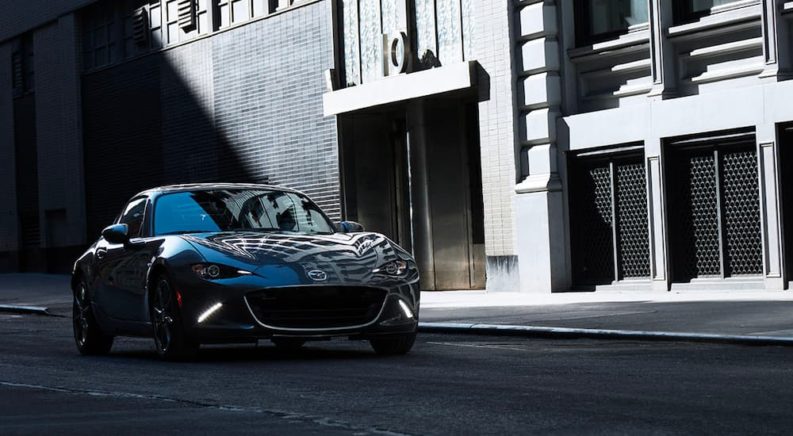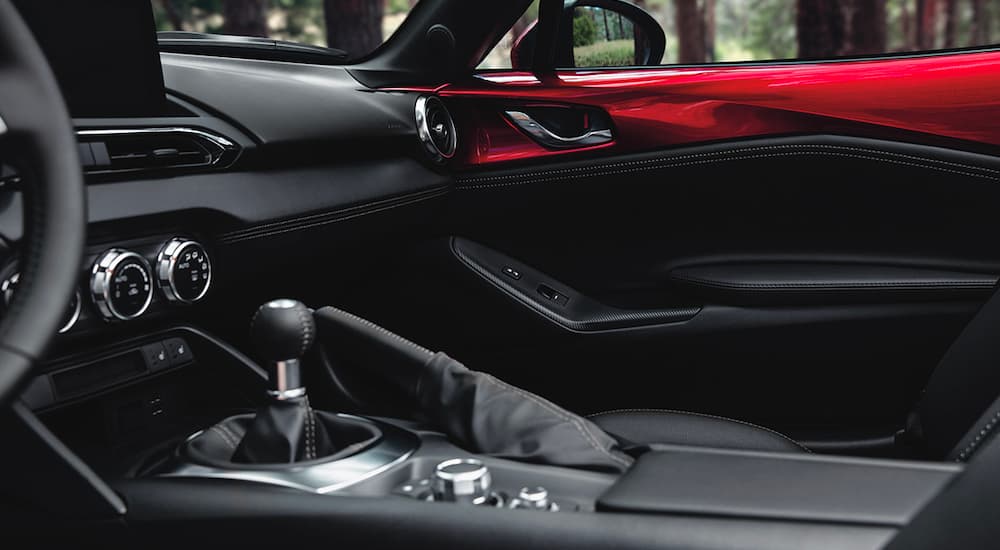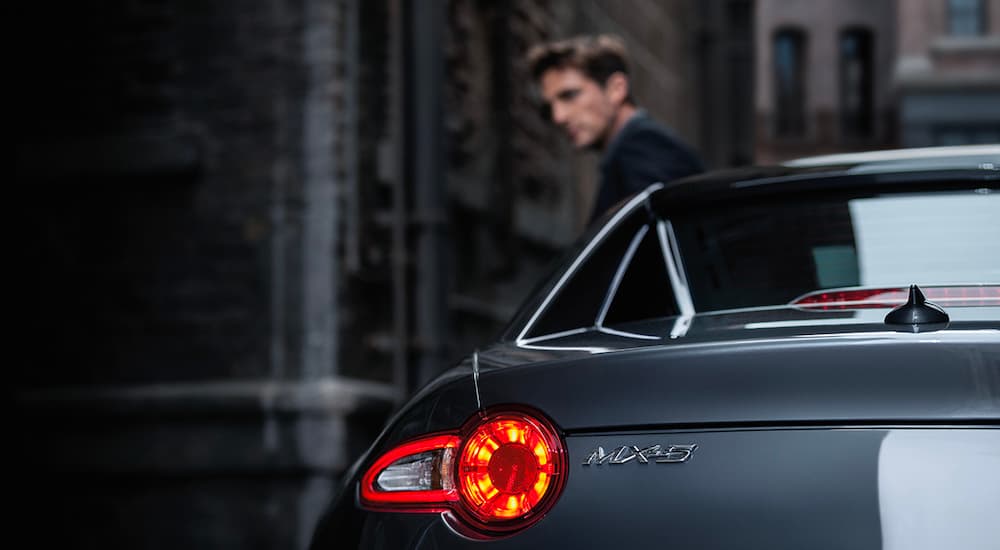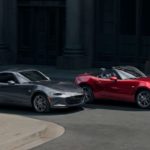“Miata,” from an Old High German word for “reward,” was Mazda’s answer to the question, “What if we had our engineering teams dogfight each other to develop a car?” That’s a hot take, I know, and more than a bit of a stretch–far from being its inception, that gritty chapter is actually the climax of Miata’s genesis story–but if we’re not having fun, what are we here for?
Entirely by coincidence and not at all by intentional design, this is the actual unspoken question to which the answer was, for the very first time, “Miata.” Although that moment was over 30 years ago, Mazda has stayed true to their two-seat roadster through four generations so that the 2023 Mazda MX-5 Miata is every bit as fun as any Miata has ever been.
Inspired by Passion
Is there any automotive body style as entertaining as a roadster? I’ll wager that there isn’t. It features low mass, a low seat, sharp looks, the wind in your hair without any compromises for practicality, and no pretension of pushing the limits of the automobile. Perhaps nobody did this better than the British firms whose 1950s-era roadsters continue to hold a cult following to this day. Bob Hall was one such fan, totally enamored by the Toyota 2000GT convertible that Sean Connery drove as James Bond (a custom model that only existed because Connery was too tall to fit inside the standard hardtop version). One day, Hall grew up to work for Mazda USA.
The economy of the 1980s enabled Mazda to greenlight Hall’s dream project, a resurrection of the iconic, if kind of lousy, tiny British roadsters. To do this in a satisfactory manner, the concept of jinba attai, “rider and horse as one” relating to the martial art of mounted archery practiced by samurai, was applied to guide engineers to a comfortable, easy-to-handle, perfectly balanced design. The driver should feel as though the car is an extension of themselves, in perfect harmony with their mount. The result was the “NA” (ie, first generation) Miata, and the rest, as they say, is history.
Attainable Enjoyment
Always ready for a joyride, the most wonderful feature of the Miata is the joy it gives the driver. The performance is just right. The 2023 Miata has a 181 hp, 151 lb-ft naturally-aspirated 2-liter four-banger attached to a 6-speed manual transmission. It goes 0-60 mph in 5.7 seconds, tops out at 140 mph, and holds 0.9 g on the skidpad with a stunning amount of body roll.
Does that sound unimpressive? Objectively it is, but that’s not the point. Because the MX-5 is so small, weighing in at less than 2400 lbs, barely 48” high, and with a 91” wheelbase, it feels faster than it is. Short gears mean you actually get to shift a couple of times before you hit the speed limit while enjoying the windup to the 7500 rpm redline. Its soft suspension creates body roll when you push it, but it’s comfortable and compliant on rougher roads. That engine manages 30 mpg combined, even when wringing it out, it sips like a 4-cylinder should.
The best part of the Miata is its affordable price. It starts at $28,050, and good luck trying to spec one out to $45,000. Let’s compare it for a second to the de-facto ultimate sports car. The Porsche 911 has 473 hp, 420 lb-fit, 0-60 in 2.8 seconds, a top speed over 190 mpg, and pulls 1.06 g on the pad. It has amazing ride quality, but weighs 3,400 lbs. First gear tops out close to the speed limit, you might get 25 highway mpg on a good day, and they cost $150,000. You can’t tell me that taking a few more seconds to hit 60 mph in a smaller, more exposed vehicle for 20% of the price, and an absolute fraction of the operating cost, is somehow unacceptable.
What’s more, the Miata is extremely novice-accessible. The current generation maintains a reputation for almost total neutrality with a 50/50 front/rear weight balance. It was rumored to be developed while factoring in the weight of the driver in the driver’s seat, helping it avoid both understeering and oversteering in all but the most extreme circumstances. That’s important because both situations represent forms of lost control, which demands real skill to regain–skills that not every driver has. In the Miata, whether you go into a turn too fast, get on the throttle too hard, or make any similar mistake, the car reacts in a gradual, predictable, controllable way, teaching a novice driver how to drive better without sending them into a ditch, or worse.
It isn’t right for everyone–like with Sean Connery, the roadster’s size makes sure of that–but neither cost nor driving talent will prevent anyone from buying and enjoying an MX-5. The easygoing nature of the transmission, the forgiving and compliant chassis, and the relatively low price point and operating costs add up to a package unlike anything else on the market. The only remotely comparable vehicle is the Toyota 86 and Subaru BRZ twins, which have a completely different style and take themselves far more seriously than the fun-for-fun’s-sake Miata. It isn’t really even close.
Track Weapon? Seriously?
The strangest thing about the Miata might be its following. I don’t mean the thousands, bordering on millions, of passionate enthusiasts who swear by Miata’s simple, exhilarating nature, but the endless hordes of detractors. And again, I don’t mean those who complain that it’s too small or impractical. Those are genuine concerns that make the car incompatible with certain people and lifestyles. I mean the people who can’t stand the MX-5’s existence, seemingly only because it’s so beloved by its fans. It’s a victim of its own success in this regard, so effective at its task that nothing can challenge it, and therefore the competition aspect of the market is rendered a moot point. There is no competition because nothing like it delivers anything close to the same feeling for a remotely affordable price. A certain kind of enthusiast despises this. In a way, this ultimate thrill machine makes the industry boring to them.
There may also be a bit of an “outsider” factor to that mentality. If you don’t have one, you’re not in the club, and if you’re an enthusiast, you want to be in the club. But you might not want to buy a Miata to get into this club, so you resent it just for existing, for being so good at what it does that it has its very own racing classes. Poor soul.
But on that last point, there are racing classes dedicated specifically to the Miata. Spec Miata was created in 1999 and rose to national prominence in 2006, with strict rules ensuring minimal modifications and the most even footing possible for drivers to showcase their own talents. The purpose is threefold: advertising (of course), career advancement, and accessibility to racing for all.
Race-ready cars for less than $40,000? Yes, please! The Miata’s easy-going nature comes into play here, too, as its communicative design is an excellent vessel for novice race drivers to learn from. The flip side of this nature is that the slightest error becomes costly, simultaneously making the Miata an exacting test of a talented driver’s precision while making the class an excellent place for drivers of all skill levels. Though today’s Spec Miata only permits first and second generation models, there’s also Spec MX-5 to provide the same venue for third-generation models, and the MX-5 Cup offers a pathway to racing the current fourth-generation models (albeit with relatively plentiful hurdles to get in).
Of course, if you’re the type who enjoys modifying cars, spec racing an MX-5 probably won’t be your jam. Thankfully, the most-raced car in North America has some of the best aftermarket support in the world, and don’t even get me started on the forums. On just one YouTube channel, a playlist of a first-generation Miata build has garnered 127 million views, showcasing how to make a project car out of a Miata to get as much out of that perfect, inexpensive platform as possible. No matter what kind of actual car stuff you’re looking to get into, there’s no better car to do it with than a Miata.
A Legend, Still Being Written
As the answer to the question, “What would Bob Hall like to see Mazda make in the future?” and now answer to… well, anything, the Miata became an iconic roadster almost overnight. Now it’s almost certainly destined to be remembered as an all-time legend and the pinnacle of driving-for-fun’s-sake design. The 2023 Mazda MX-5 Miata makes no exception to the rule. It continues to embody the joyful spirit of a small roadster, providing genuine thrills at road-safe speeds and budget-safe prices without sacrificing ride or material quality. The popular acronym might not literally hold true, but if your questions about cars have anything to do with loving the drive or my choice of section headers and section-opening words, “Miata Is Always The Answer.”






